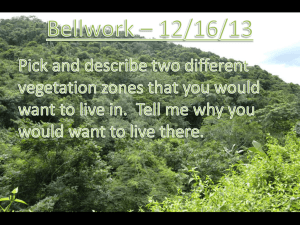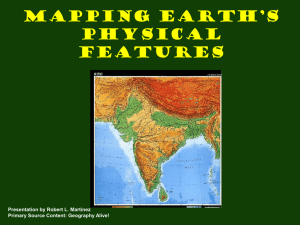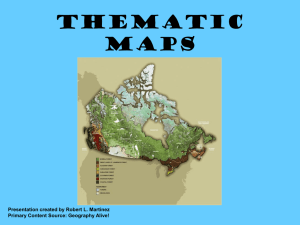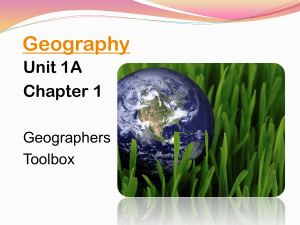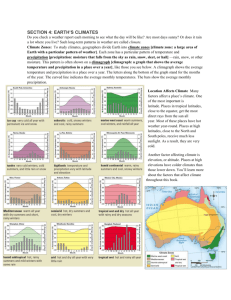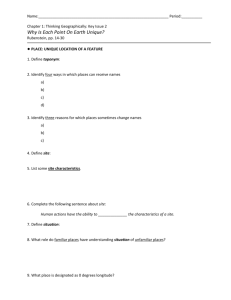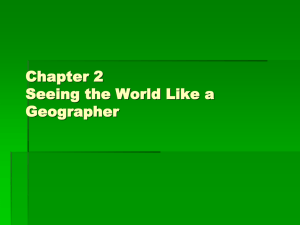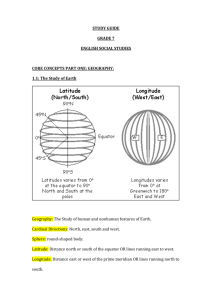File
advertisement
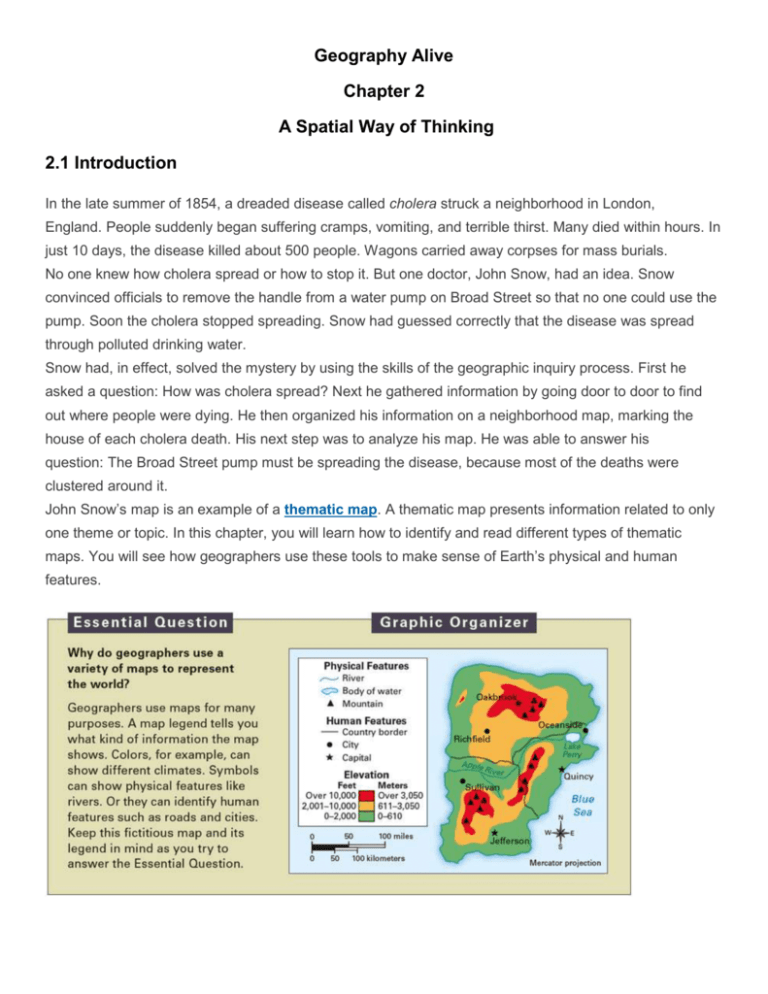
Geography Alive Chapter 2 A Spatial Way of Thinking 2.1 Introduction In the late summer of 1854, a dreaded disease called cholera struck a neighborhood in London, England. People suddenly began suffering cramps, vomiting, and terrible thirst. Many died within hours. In just 10 days, the disease killed about 500 people. Wagons carried away corpses for mass burials. No one knew how cholera spread or how to stop it. But one doctor, John Snow, had an idea. Snow convinced officials to remove the handle from a water pump on Broad Street so that no one could use the pump. Soon the cholera stopped spreading. Snow had guessed correctly that the disease was spread through polluted drinking water. Snow had, in effect, solved the mystery by using the skills of the geographic inquiry process. First he asked a question: How was cholera spread? Next he gathered information by going door to door to find out where people were dying. He then organized his information on a neighborhood map, marking the house of each cholera death. His next step was to analyze his map. He was able to answer his question: The Broad Street pump must be spreading the disease, because most of the deaths were clustered around it. John Snow’s map is an example of a thematic map. A thematic map presents information related to only one theme or topic. In this chapter, you will learn how to identify and read different types of thematic maps. You will see how geographers use these tools to make sense of Earth’s physical and human features. 2.2 A Geographic Setting Thematic maps are all around us. Tune in to a news program and you’re likely to see a weather map showing high and low temperatures. To find your way on the local bus system, you might use a map of bus routes. These maps focus on a specific topic, or theme. They show information about some aspect of physical or human geography. Thematic Maps Can Show Physical Geography Some thematic maps focus on physical features. Physical features are natural parts of Earth’s surface. They include landforms like mountains, plains, and plateaus. They also include bodies of water. A physical features map of Earth will show oceans, seas, bays, rivers, and lakes. Thematic maps can show other aspects of the physical environment. For example, some maps focus on climate, or long-term patterns of weather. Climate maps show how much rainfall various areas receive. They also show how hot or cold places tend to be in winter and summer. Climate has a big effect on the types of vegetation, or trees and other plants, that will grow in an area. You can see this by comparing a climate map of Earth with a vegetation map. A vegetation map shows the kinds of trees and other plants that grow in various places. In many ways it looks like a climate map, although other factors also affect what will grow where. Thematic Maps Can Show Human Geography Thematic maps can also focus on human geography. John Snow’s map of the cholera deaths near the Broad Street pump is a good example. Another example is a political map. The map on the next page shows the borders of the 50 U.S. states. It also shows the borders between countries. In addition to borders, political maps also show important cities, such as the capitals of states and countries. Another type of thematic map shows population density. This is the number of people per unit of area, such as a square mile. The higher the number, the more crowded an area is. A population density map reveals where large numbers of people cluster. Besides showing where people live, a thematic map can show what they do. A map of economic activity focuses on the ways people produce, buy, and sell goods and services. This kind of map might show the main types of business and industry in an area.It might also show the natural resources that fuel the area’s economy. Natural resources are useful items found in nature, such as wood, coal, and oil. A Map’s Title and Legend State Its Theme To read a thematic map, first look at its title.The title states the topic of the map. Then look at the map legend. It tells you how to read the map’s symbols. On the U.S. political map, the legend shows the symbols for the national and state capitals. A map legend may also explain how the map uses colors. For instance, a thematic map might use colors to show differences in elevation or population density. 2.3 Mapping Earth’s Physical Features In the winter, snowboarders look for a snowy mountain to practice their sport on. In the summer, vacationers often cool off by a lake or river. These are just three of the landforms and bodies of water that you might see on a physical features map. Common Landforms Geographers have given names to the many landforms found on Earth. Some landforms have distinctive shapes when viewed from above. A long, narrow peninsula, for example, juts out from a continent into water. Other landforms, like mountains, have distinct shapes when viewed from the ground. Physical features maps show the shapes of features as seen from above. They also show the elevation, or height above sea level, of various features. Usually physical features maps use colors and shading to show changes in elevation. Bodies of Water Geographers also label bodies of water on physical features maps. Many kinds of water bodies appear on the continents. For example, rivers flow down from mountains and make their way to the sea. Lakes are entirely surrounded by land. Other water bodies are created where oceans and seas meet the continents. A bay is partly enclosed by a wide, curving stretch of land. A strait is a narrow channel that connects two larger bodies of water. 2.4 Hot, Cold, Wet, Dry: Earth’s Climates Do you check a weather report each morning to see what the day will be like? Are most days sunny? Or does it rain a lot where you live? Such long-term patterns in weather are called climate. Climate Zones To study climates, geographers divide Earth into climate zones. Each zone has a particular pattern of temperature and precipitation—rain, snow, or other moisture. This pattern is often shown on a climagraph, like those you see below. A climagraph shows the average temperature and precipitation in a place over a year. The letters along the bottom of the graph stand for the months of the year. The curved line indicates the average monthly temperatures. The bars show the average monthly precipitation. Location Affects Climate Many factors affect a place’s climate. One of the most important is latitude. Places in tropical latitudes, close to the equator, get the most direct rays from the sun all year. Most of these places have hot weather year-round. Places at high latitudes, close to the North and South poles, receive much less sunlight. As a result, they are very cold. Another factor affecting climate is elevation, or altitude. Places at high elevations have colder climates than those lower down. You’ll learn more about the factors that affect climate throughout this book. 2.5 Trees and Other Plants: Earth’s Vegetation Think about the climate where you live. Now think about the kinds of plants that grow nearby. In an arid climate, like a desert, you might see hardy cacti. In a humid continental climate, you might see lofty trees that stay green all year. Climate has a major effect on the kind of vegetation that grows in a place. Vegetation Is Adapted to Its Environment Plants of some kind grow nearly everywhere on Earth. But in order to survive, plants must adapt to their environment. Plants can adapt to even extreme environments. A tundra climate zone is very cold and dry. Yet small plants and bushes grow there. In arid climates, cacti can go for long periods without water. Other kinds of vegetation need lots of rainfall to survive. Other factors besides climate affect what plants grow where. Among them are elevation, amount of sunlight, and richness of the soil. Global Vegetation Zones Geographers study where different plants grow by dividing the world into vegetation zones. In each zone, a certain mix of plants has adapted to similar conditions. Like climate zones, vegetation zones are affected by their location on Earth. They range from the barren ice cap zones at the poles to the dense broadleaf evergreen forest zones near the equator. 2.6 Where People Live: Population Density In 2007, about 8 million people lived in New York City. They were jammed into an area of about 300 square miles. Compare this with the town of Skwentna, Alaska, where approximately 150 people were spread out over about 450 square miles. When it comes to crowding, these two places are about as different as they can be. Geographers show these kinds of differences using population density maps. Population Density Measures Crowding Population density tells us how crowded a place is. To calculate the density of a place, divide the number of people there by its land area. The higher the result, the more crowded the place is. In 2007, New York City had a population density of about 26,000 people per square mile. In contrast, Skwentna had less than 1 person per square mile. Population density affects how people live. In Skwentna, houses are spread out. There are no roads. People use airplanes, boats, or snowmobiles to get to the local store and the post office. Skwentna’s version of rush hour comes in February, when dogsled racers speed through town. In New York City, people live packed in high-rise apartments. They may have hundreds of neighbors just in their own building. Every day millions of “straphangers” hold on tight as they jostle one another in the city’s crowded subways. 2.7 Economic Activity: Land and Resources Do you like chocolate? This sweet treat comes from cocoa beans, the fruit of the cacao tree. The cacao tree grows only in hot, tropical areas near the equator. But factories that use cocoa beans to make chocolate candy are found in Europe and the United States.The locations of cocoa plantations and candy factories are examples of the kind of information you might see on an economic activity map. Land Use Shows How People Make a Living Economic activity maps often show patterns of land use. Land use is the way people use the land they live on to meet their needs. In some areas, people use land for farming. In others, they may use it for mining. Natural Resources Affect Economic Activities Economic activity also depends on a country’s natural resources. Forestry, or the harvesting of trees to produce wood products, is important in forested areas. Near oceans, fishing is an important industry. Many resources lie hidden beneath the ground. This is true of both minerals and fossil fuels such as oil, coal, and natural gas. Uranium is another underground energy resource. It provides fuel for nuclear power plants. In contrast, moving water is an easy-to-find energy resource. Dams can be built on rivers to harness the moving water’s energy and convert it to hydroelectric power. 2.8 Organizing Earth’s Surface: Regions As you have learned, geographers use many kinds of maps to make sense of the world.Some of these maps focus on physical geography. Others focus on human geography. All of them reveal interesting patterns to explore. Geographers use these patterns to organize the Earth’s surface into regions. A region is an area with one or more features that set it apart from other areas. As you’ll see, the concept of region allows geographers to divide the world in useful ways. Unique Features Define a Region Think about the community you live in. Does it have a business district? A shopping mall? An industrial park? A civic center? A residential neighborhood? Each of these areas has features that set it apart from other areas. You might think of one as a business region, another as a shopping region, and still another as a housing region. Each region looks different. Each has a different purpose. Each has different needs. Geographers define regions in several ways. The Sunbelt is a region defined by physical features. It is a region made up of states in the southern part of the United States. What sets the Sunbelt apart from other regions is its warm, sunny climate. The Corn Belt is a region defined by human features. It is made up of states in the center of the country where raising corn is an important economic activity. Dividing the World into Seven Major Regions The world is a very large place to make sense of. For this reason, geographers usually divide it into regions to study. These world regions are still very large. But each has its own special features. This book divides the world into seven major regions. Each region is shown in a different color on the world regions map below. These colors are your guide to finding each region in this book. Your study of a region will begin with an introduction to its most important physical and human features. In that introduction, you will begin to see what makes each of these regions unique. SUMMARY Geographers use maps for many different purposes. Thematic maps, which present information related to only one theme, help geographers make sense of Earth’s physical and human features. Because thematic maps focus on one topic, geographers are able to find out specific information about a place. Thematic maps can tell information about physical features of a place or even what type of economic activities take place there. The world is divided into seven major regions. These regions are divided into smaller regions. Because unique features define a region, different types of maps apply to different places
